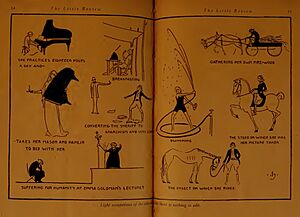The Little Review facts for kids
The Little Review was an exciting American magazine. It was started by Margaret Anderson in Chicago in 1914. This magazine published new and experimental writing and art until 1929. With help from Jane Heap and Ezra Pound, Anderson created a place for many modern artists and writers. These contributors came from America, Britain, Ireland, and France. The Little Review also showed early examples of surrealist art and Dadaism. The magazine is most famous for publishing parts of James Joyce's famous novel, Ulysses.
Contents
The Little Review Magazine
How It Started
Margaret Anderson had the idea for The Little Review in 1914. This was during a time when Chicago was a hub for new literature. She named it after the Chicago Little Theatre, which supported new plays. In her first message in the magazine, Anderson said she wanted a new way to think about art. She believed that truly understanding art was important. This idea guided the magazine for its whole fifteen-year run.
In its early years, The Little Review published many types of writing. These included stories, essays, and poems. The magazine also supported ideas like feminism, which means equal rights for women. For a short time, it even explored anarchism, a political idea about how society should be organized. Emma Goldman was a key person during this time. She wrote for the magazine, and Anderson also wrote articles supporting these ideas. In 1916, Jane Heap became a co-editor and stayed with the magazine until it ended.
For a while in 1916, The Little Review was published from San Francisco. Margaret Anderson and Jane Heap even worked on it from a ranch near Muir Woods in California. Later, in 1917, the magazine moved to Greenwich Village in New York City. After that, Margaret Anderson took it to Paris, France.
Ezra Pound, a famous writer, joined the magazine in 1917. He became the foreign editor. He felt that The Little Review was the right place for the kind of work he wanted to see published.
Facing Challenges
The Ulysses Story
The magazine started publishing parts of James Joyce's novel Ulysses in 1918. The Little Review continued to print sections of the book until 1921. At that time, the Post Office stopped distributing copies of the magazine. They said that parts of Ulysses were inappropriate.
Because of this, the magazine, Margaret Anderson, and Jane Heap had to go to court. John Quinn, a lawyer who supported modern art, defended them. However, they lost the case. The editors each had to pay a fifty-dollar fine. After the trial, Anderson thought about closing the magazine.
The court case was later mentioned in a book called Girls Lean Back Everywhere. This book was written by a lawyer named Edward de Grazia. The book's title came from a quote by Jane Heap. She wrote about the situation, defending James Joyce's writing. She argued that the novel showed life as it was, and that it was not harmful.
Special Issues
The Blank Pages
One interesting issue was published in September 1916. This was when the magazine was in California. This issue of The Little Review had several blank pages at the beginning. Margaret Anderson explained that writers had not sent in enough good work. She wrote on the first page that the issue was like a "Want Ad" for new material.
After the blank pages, Anderson published essays that showed the magazine's interests. These included pieces about important social events of the time. The blank pages made some readers angry, but others found it amusing. Some readers were also annoyed by cartoons in the issue. These cartoons showed the editor doing things like riding her horse or playing piano.
The Exiles Issue
The Spring 1923 issue was called "Exiles." It was special because it featured works by American writers living in Paris. It also included art from the Parisian avant-garde, which means very new and experimental artists. Famous names like Ernest Hemingway, Gertrude Stein, and E. E. Cummings were in this issue.
Perhaps the most important part of this issue was six short stories from Hemingway's first novel, in our time. The issue also included works by French artists like Fernand Léger and Jean Cocteau. Its experimental front cover showed the modern tastes of editor Jane Heap.
The Final Issue
The last issue of The Little Review came out in May 1929. It was made up of letters and answers to questionnaires from over fifty artists. These included James Joyce, Wyndham Lewis, and Ezra Pound. Jane Heap mostly designed the questionnaire. Many artists found the questions boring. Emma Goldman, for example, said she was late in replying because the questions were "terribly uninteresting."
Even Anderson and Heap agreed that the questions were not very helpful. Anderson ended the magazine with a final message in this 1929 issue. She said that "even the artist doesn't know what he’s talking about," referring to the questionnaire. She felt it was time to move on from the magazine.
Who Wrote For It?
The Little Review featured many important writers and artists. They helped make the magazine a key part of the modern art movement.
In Literature
|
In Art
|


